Disclosure: This post may contain affiliate links. I may earn a small commission for my endorsement, recommendation, testimonial, and/or link to any products or services from this website.
Tender, juicy, savory, and sweet — this cider braised pork shoulder is comfort food at its finest! The pulled pork is perfect for a chilly fall evening after a day at the orchard — just let it simmer slowly in a Dutch oven or in a Crock Pot.
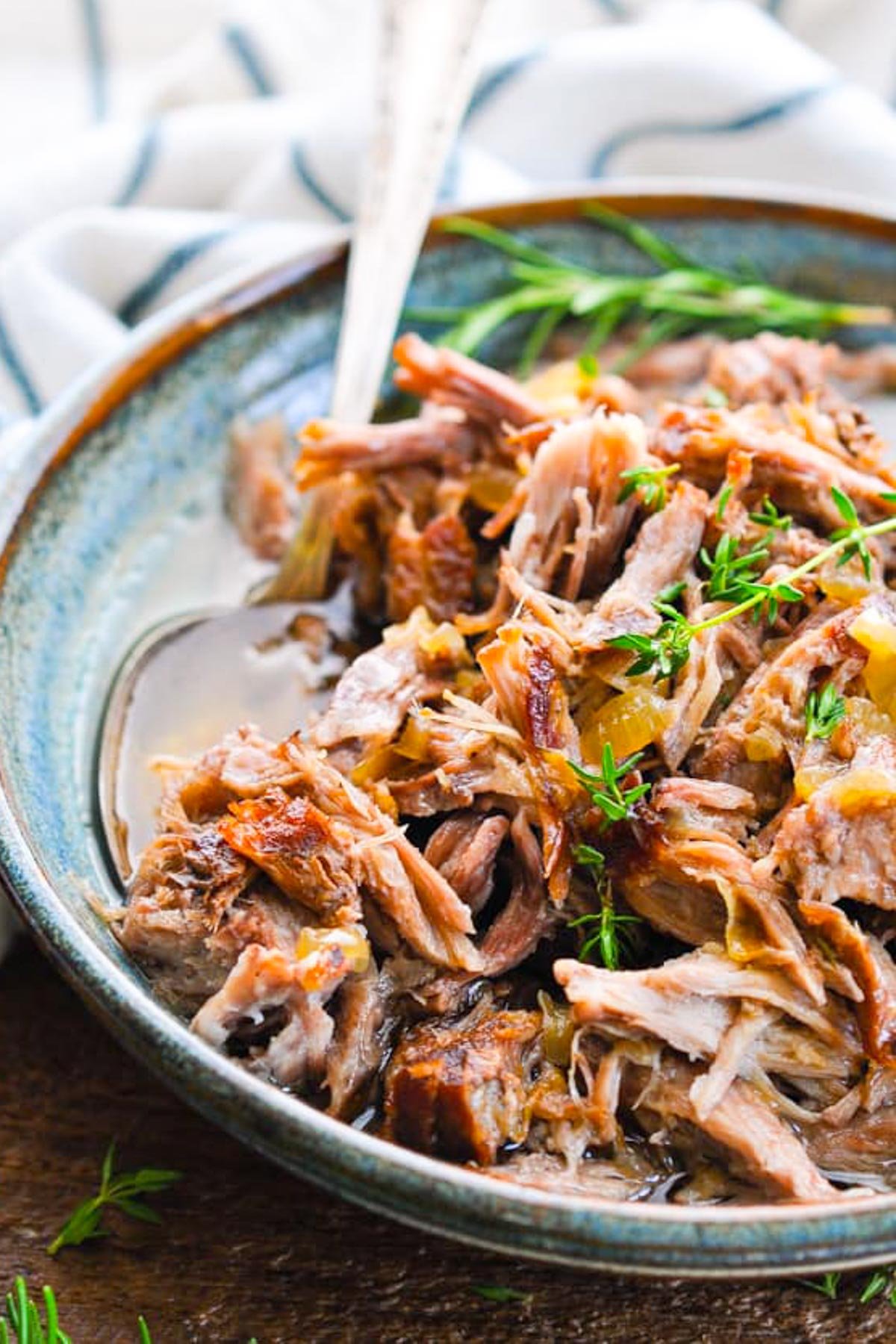
Table of Contents
If you’re looking for even more delicious pork shoulder recipes, be sure to try this Mississippi pulled pork, these Dutch oven carnitas, this Crock Pot beer pulled pork with maple bbq sauce, and these honey lime slow cooker pulled pork tacos, too!
How to Make Braised Pork Shoulder | 1-Minute Video
Why You’ll Love this Recipe
Braised meat refers to any tough cut of meat that is slowly and gently cooked in liquid until it becomes flavorful, juicy, and fall-off-the-bone tender. For this braised pork shoulder recipe, you’ll slow cook a pork roast in a Dutch oven (or in a Crock Pot) with a flavorful blend of onions, garlic, herbs, and apple cider for the best pork shoulder roast that you’ve ever tasted! Pair the meat with mashed potatoes or biscuits, or pile it high on sandwich buns. Everyone will love this cozy and easy dinner!
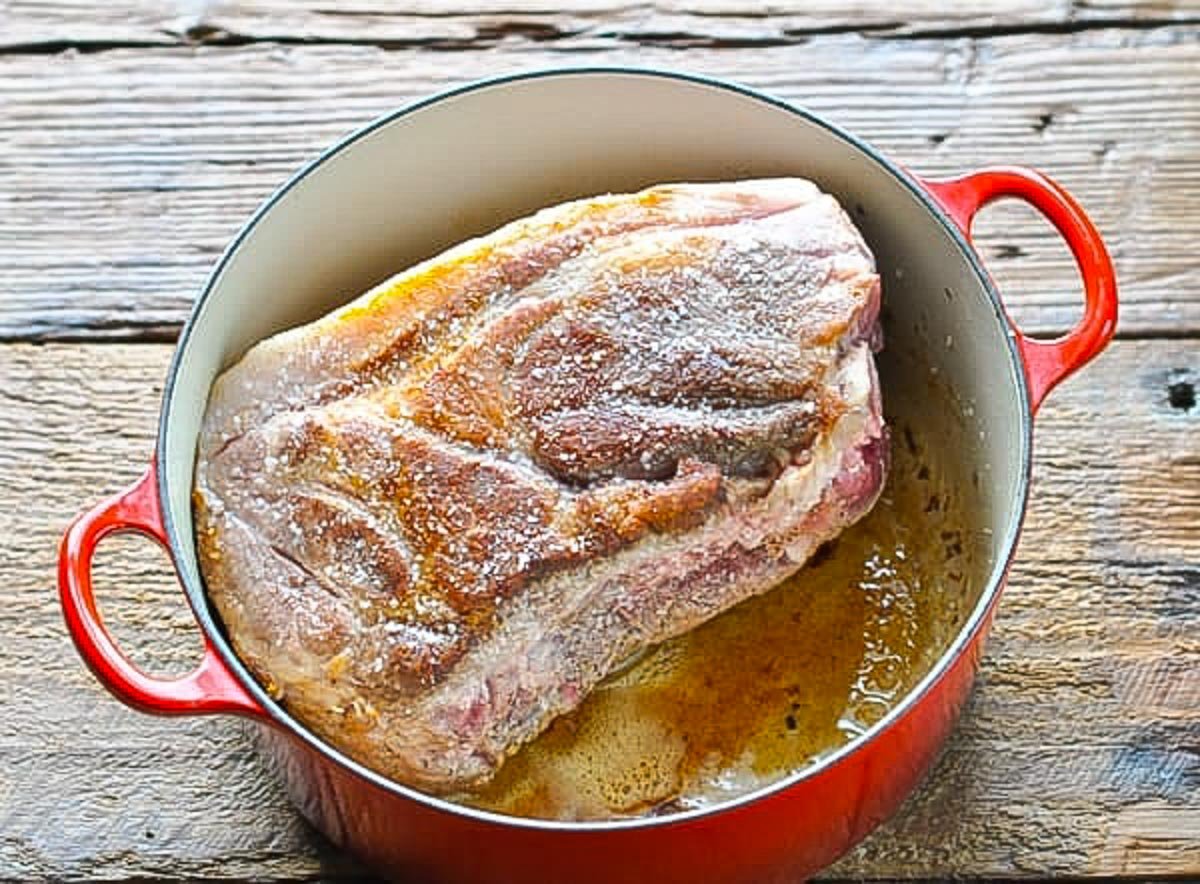
The Best Cut of Pork for Braising
The best cut of pork for braising is called a “pork butt,” “pork shoulder,” or “Boston butt.” Boston butt comes from high on the hog, above the shoulder blade. It has a lot of marbled fat, which lends itself well to juicy, slow-cooked meat.
This recipe calls for a bone-in pork butt since the bone adds even more flavor to your meat; however, you can certainly use a boneless pork shoulder roast instead. In general, a boneless pork butt will require slightly less time in the oven than a bone-in piece of meat, so keep an eye on it and adjust accordingly.
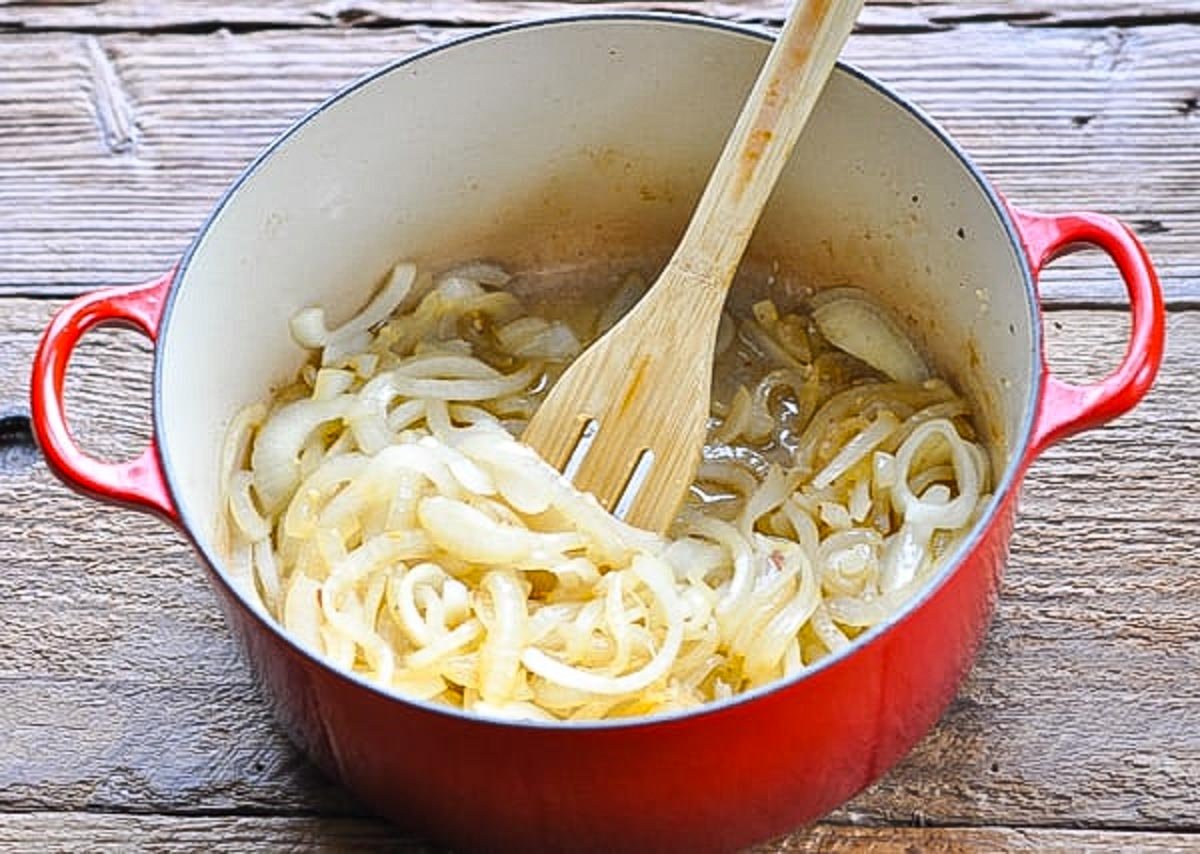
Ingredients
This is a quick overview of the ingredients that you’ll need for a succulent and delicious oven braised pork shoulder. As always, specific measurements and complete cooking instructions are included in the printable recipe box at the bottom of the post.
- Bone-in pork shoulder roast: also called a “pork butt” or “Boston butt,” this relatively inexpensive cut has a lot of marbled fat, which keeps the meat juicy and fork tender during the long cooking process. A boneless pork shoulder roast will also work well.
- Oil: to sear the pork. I use vegetable oil for its high smoke point, but you can sub with canola oil or another neutral oil, or even extra-virgin olive oil.
- Onions, garlic, bay leaf, fresh thyme, and fresh rosemary: aromatics that flavor the meat as it slowly roasts.
- Apple cider: the braising liquid. This gives the pork a very subtle sweet, apple taste. It’s not a strong flavor at all. Apple juice isn’t quite as robust, but it will work as a substitute in a pinch.
- Chicken broth: additional braising liquid. Chicken stock works well, too.
- Kosher salt and ground black pepper: to enhance the flavors in the dish. Don’t be shy — this is a large piece of meat, so season liberally.
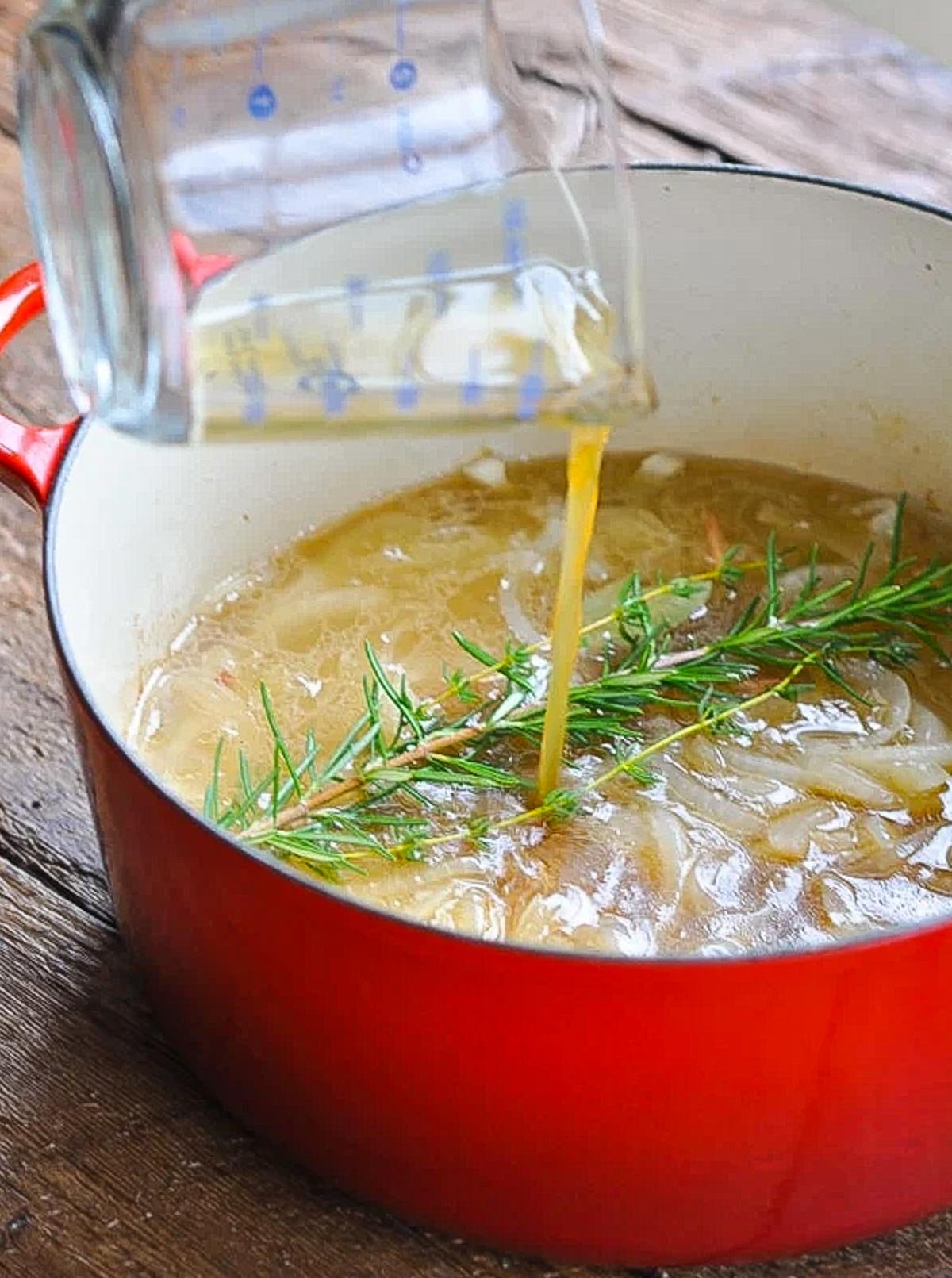
Instructions
Preparing a slow braised pork shoulder roast is very similar to making a pot roast. Braising, which comes from the French word braiser, is a combination-cooking method that uses both wet and dry heats: typically, the meat is first seared at a high temperature, and then it’s finished in a covered pot with liquid at a lower temperature.
The process is incredibly easy, but it does require patience, as slow-cooking is the name of the game. At least most of your effort will be completely hands-off! I’ve included the detailed instructions in the recipe card at the bottom of the post, but here’s the short version:
- Sear the pork in a large Dutch oven.
- Add onions and garlic.
- Pour in liquid and seasoning.
- Return the pork to the pot, fat-side up.
- Cover and cook in the oven for about 3 – 3 ½ hours, or until it’s fall-apart tender. If using a meat probe thermometer, you’re looking for an internal temperature of about 205°F.
- Shred with two forks, and serve!
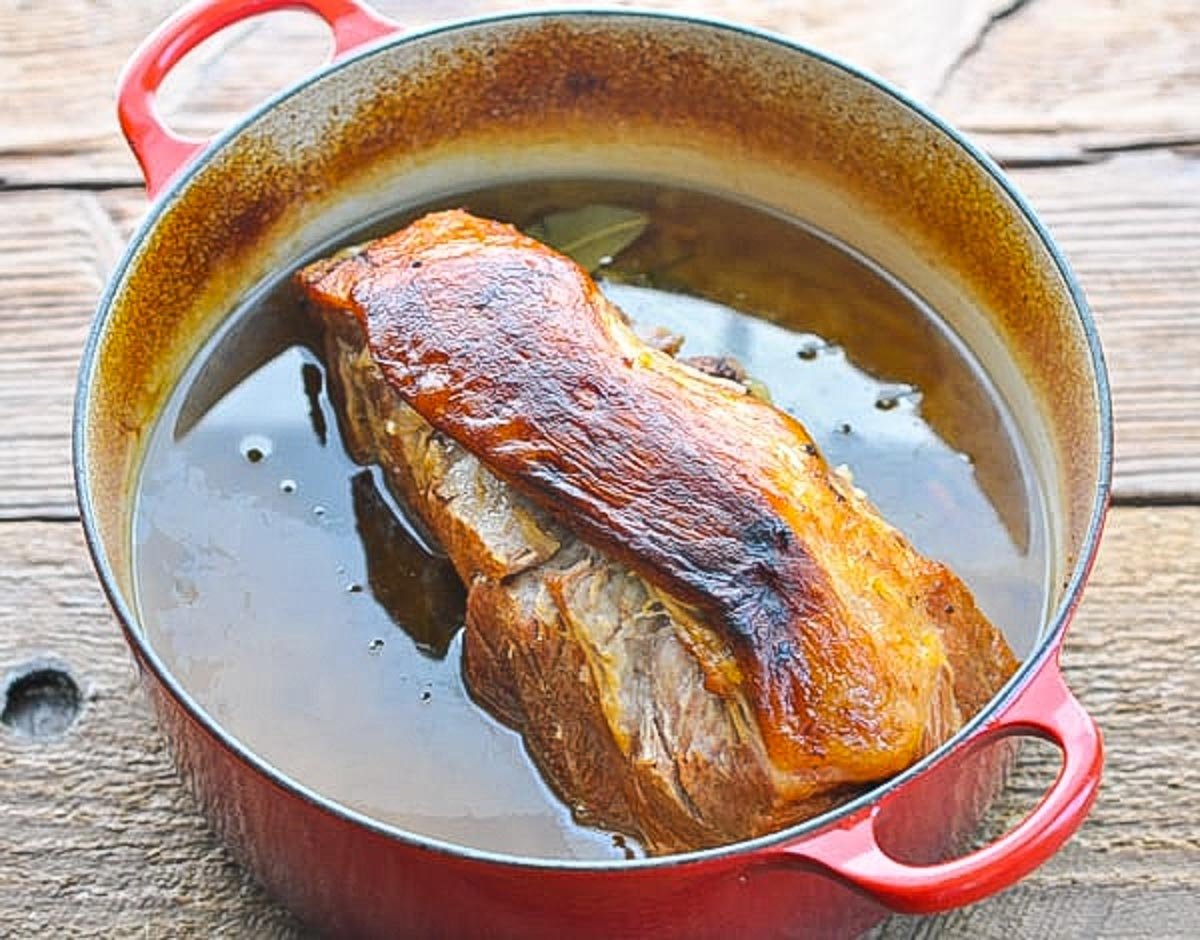
Serving Suggestions
This cider braised pulled pork is a versatile and easy meal. I love to simmer a pot in the oven on a crisp Sunday afternoon after a weekend at the apple orchard! Nothing says cozy, Virginia fall comfort food more than this simple, hearty dish. It’s also great for tailgating, for entertaining, or for feeding a crowd. Pile it onto sandwich (or slider) buns, make braised pork shoulder tacos, stuff it in baked potatoes, add your favorite veggie, or pair it with any of these sides:
- Wedge Salad with Buttermilk Ranch Dressing, Green Salad with Red Wine Vinaigrette, House Salad with Candied Pecans, Mixed Greens with Dijon Vinaigrette, Marinated Vegetable Salad, or Classic Caesar Salad
- Buttermilk Biscuits, Flaky Buttermilk Biscuits, Sweet Potato Biscuits, Aunt Bee’s 3-Ingredient Buttermilk Biscuits, Cheese Biscuits, Pumpkin Spice Biscuits, or Drop Biscuits
- 3-Ingredient Sour Cream Muffins
- Pumpkin Bread or Pumpkin Muffins
- Charleston Red Rice or Rice Pilaf
- Creamy Baked Mac and Cheese, Duke’s Homemade Mac and Cheese, Pumpkin Mac and Cheese, Crock Pot Mac and Cheese, No-Boil Overnight Mac and Cheese, Shells and Cheese, or Creamy Stovetop Mac and Cheese
- Southern Cornbread, Pumpkin Cornbread, Cake Mix Cornbread, Skillet Cornbread, Sweet Cornbread, Jiffy Cornbread with Creamed Corn, Corn Sticks, Honey Cornbread or Cornbread Muffins
- Southern Macaroni Salad, Classic Pasta Salad, or Shrimp Pasta Salad
- Coleslaw or Vinegar Coleslaw
- Southern Collard Greens
- Baked Potato Wedges, Mashed Potatoes with Sour Cream and Chives, Skin On Mashed Red Potatoes, or Easy Potato Salad
- Arkansas Green Beans with Bacon, Southern-Style Green Beans, or Roasted Green Beans
- Broccoli Cauliflower Salad
- Fried Apples or Baked Apple Slices
- Southern Succotash
- Creamed Peas
- Hoppin’ John
- Roasted Root Vegetables
- Oven Roasted Brussels Sprouts with Bacon
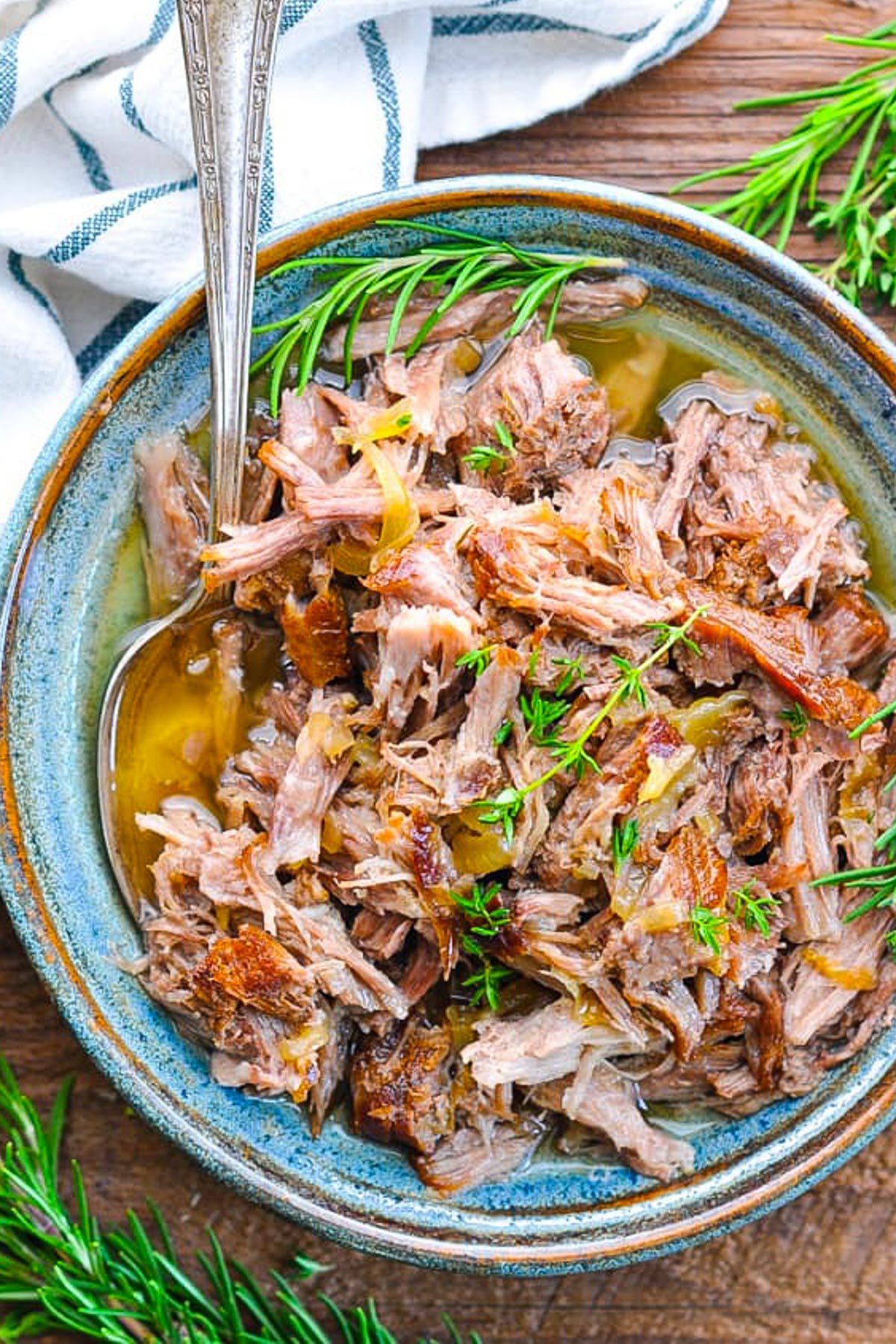
Preparation and Storage
- Make Ahead: to prepare this dish in advance, refrigerate the braised pork (before shredding) in its cooking liquid with the onions overnight. The next day, when the dish is chilled, skim the fat from the top. Reheat the pork in a 325°F oven, and shred just before using.
- If you want to reheat your cooked pork in a Crock Pot, place the cooked pork (and all of the reserved juices) in the slow cooker on the “WARM” setting for 2-4 hours.
- Leftovers will stay fresh in an airtight container in the refrigerator for 3-4 days. To keep the pork longer, you can wrap the cooked meat in foil, and then freeze in an airtight container or Ziploc freezer bag for up to 3 months.
Crock Pot vs. Dutch Oven
If you’re going to be out of the house for most of the day, you can braise your pork shoulder in the slow cooker instead of in the oven. To do so, sear the pork according to the recipe instructions. Sauté the onions and garlic in the pot according to the recipe instructions, too. Transfer the onions to the Crock Pot, stir in the remaining ingredients, and add the pork. Cover and cook on LOW for 8-10 hours or on HIGH for 4-5 hours.
The cast iron Dutch oven is always my preference over the Crock Pot, if you have a choice between the two. The Dutch oven is convenient (and requires fewer dishes) because you can sear the meat on the stovetop and move the entire pot to the oven for braising later. The tight-fitting lid traps moisture in the pot, and the cast iron distributes the indirect heat from the oven more evenly than the heating element in a slow cooker does. Finally, it’s easier to control the oven temperature and time when using a Dutch oven than it is to control the temperature of your Crock Pot.
Frequently Asked Questions
- What is the best temperature to braise a pork shoulder? Braising requires a longer cooking time at a low temperature. This allows the tough meat fibers to break down and become tender. A typical oven temperature for braised pork shoulder is in the range of 275°F – 325°F. I suggest 325°F for this recipe, but if you have more time and you’d like to let the pork roast for even longer, you can set the oven at 275°F and cook the pork for at least 5 hours.
- Why sear the pork first? Searing the pork before adding it to the liquid and other ingredients helps to brown the surface and enhance the flavor. A hot pan can creates a golden, caramelized crust through a process called the Maillard reaction, and will also lock in the meat’s juices. Whether you’re braising the pork in a Dutch oven or in a Crock Pot, don’t skip this important step!
- Should braising liquid cover the meat? No, the liquid should not cover the meat in the pot. You want just enough cider and broth to surround (but not submerge) the pork. We’re braising — not boiling.
- Should the lid stay on or off of the pot? Keep the Dutch oven (or slow cooker) covered while the pork braises in the oven. This creates a moist environment, trapping the juices inside the pot.
- Why is my braised pork shoulder tough? This recipe shouldn’t turn out dry or tough at all, because the braised pork shoulder just gets juicier and more tender as it cooks. If you find that your braised meat is dry, it’s likely that you’re using the wrong cut of meat (such as a lean tenderloin). It’s pretty hard to over-cook or braise the pork shoulder roast for too long. Just let the oven (or slow cooker) do its job while you sit back and enjoy the delicious aromas wafting from the kitchen!
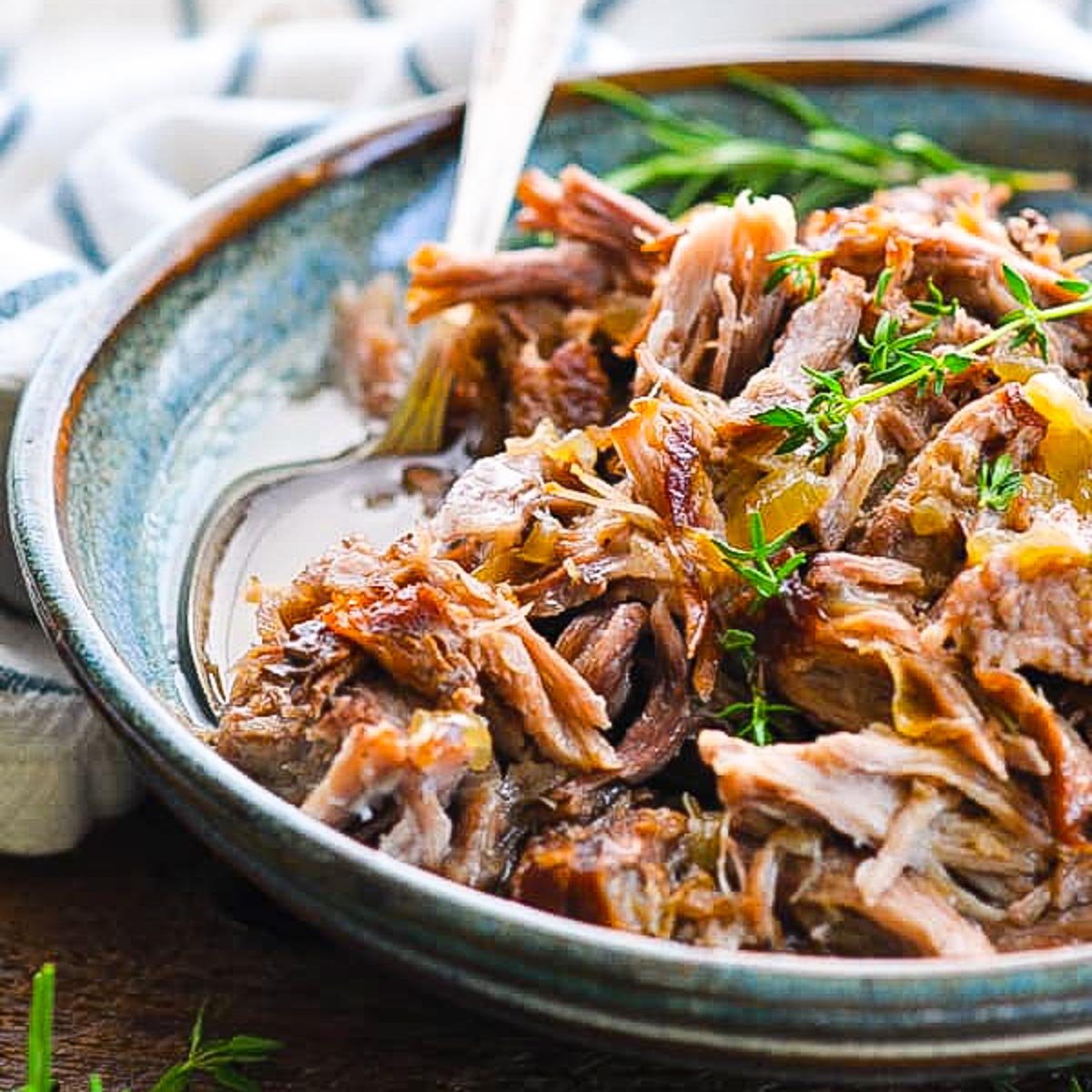
Recipe Variations
- Use a boneless pork shoulder roast instead of a bone-in roast. You may need to reduce the cooking time slightly for the boneless roast.
- For a sweeter, more bold cider flavor, replace the chicken broth with extra apple cider. You can also add sliced apples to the pot.
- Stir in a splash of apple cider vinegar or a dollop of Dijon mustard for a little bit of acidic tang.
- Add extra herbs, spices, and seasonings to the pot. For instance, try a couple sprigs of fresh oregano or fresh parsley, or season the meat with a bbq rub, our favorite house seasoning, coriander, or ginger. Cayenne pepper or crushed red pepper flakes will give the dish some heat, too!
Expert Tips
- Searing the pork before adding it to the liquid and other ingredients helps to brown the surface and enhance the flavor.
- The cast iron Dutch oven is always my preference over the Crock Pot. It sears the meat nicely, the tight-fitting lid traps moisture in the pot, and the cast iron distributes the indirect heat from the oven more evenly than the heating element in a slow cooker does. Finally, it’s easier to control the oven temperature and time when using a Dutch oven.
- If you’re using the Crock Pot, you may need to adjust the cooking time, depending on how hot your slow cooker runs (and how big your pork is).
- Transfer the meat to a large rimmed baking sheet or a large bowl to shred the pork with two forks. This contains the juices so it’s not as messy.
- If your pulled pork is tough, it’s probably because you haven’t cooked it long enough. The collagen in the meat is what keeps it tough, so you need to allow plenty of time for those fibers to break down.
- Cooking for a Smaller Family? This meat freezes really well! Package leftovers in individual containers, label them, and stash them in the freezer. The pulled pork is delicious served on sandwich rolls, on salads, tacos, stuffed in baked potatoes, in a casserole, in quesadillas, on nachos, or on pizza.
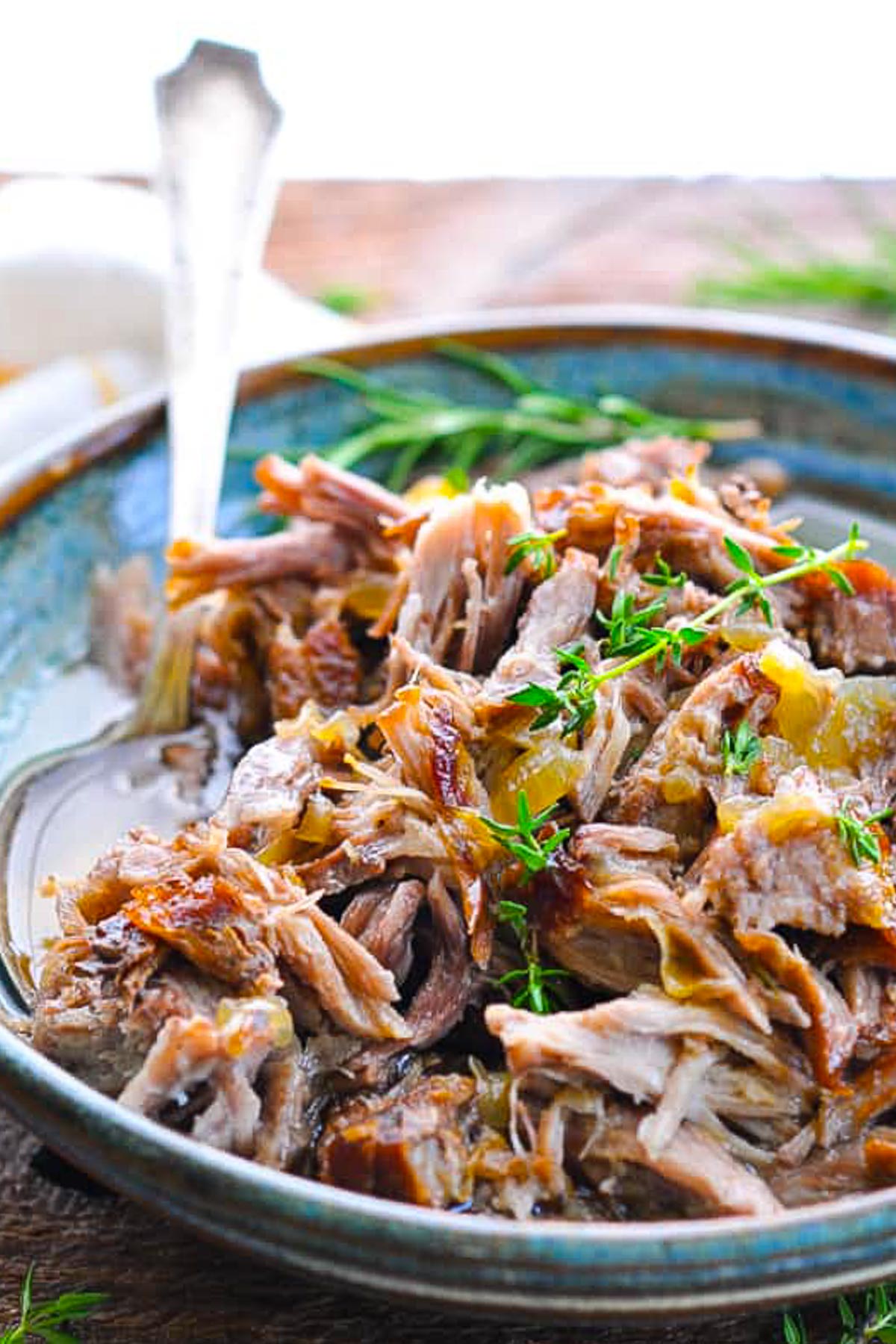
More Pork Shoulder Recipes to Try
Crock Pot Pulled Pork with Apricot Preserves
12 hours hrs 15 minutes mins
Pork Ragu {Crock Pot or Stovetop}
6 hours hrs 10 minutes mins
Dutch Oven Pork Stew
2 hours hrs 35 minutes mins

Apple Cider Braised Pork Shoulder
Ingredients
- 1 (6-7 lb.) bone-in pork shoulder (or “Boston butt” or “pork butt”)
- 2 tablespoons vegetable oil
- 3 large onions, thinly sliced (about 3 cups total)
- 4 cloves garlic, minced (about 4 teaspoons total)
- 1 bay leaf
- 3 sprigs fresh thyme
- 1 sprig fresh rosemary
- 1 ½ cups apple cider
- 1 cup chicken broth
- Kosher salt and ground black pepper, to taste
- Optional, for serving: warm bbq sauce
Instructions
- Preheat oven to 325°F. Pat pork dry with paper towels; season liberally with salt and pepper on all sides.
- Heat the vegetable oil in a large Dutch oven (at least 7 quarts) over medium heat. Brown the pork on all sides, taking care not to get the oil too hot, about 6-7 minutes per side. Remove the meat to a platter.
- Add the onions and garlic to the pot. Cook, stirring occasionally, until the onions are tender, about 10-15 minutes.
- Stir in 1 ½ teaspoons salt, bay leaf, thyme, rosemary, apple cider, and chicken broth. Nestle the pork shoulder in the pot (fat-side up). Cover the pot.
- Roast the pork shoulder in the 325°F oven for about 3 ½ – 4 hours, basting with cooking liquid every hour or so, if possible. The pork is done when the meat reaches an internal temperature of 205°F. At this point, it should fall apart easily when pulled with two forks. Discard the bay leaf and herb stems. Transfer the pork to a large cutting board. When it's cool enough to handle, shred the meat with two forks (discarding fatty pieces). Spoon plenty of that delicious cider cooking liquid and onions over top, or toss the pulled pork with warm barbecue sauce.
Video
Notes
- Alternate Slow Cooker Instructions: If you’re going to be out of the house for most of the day, you can braise your pork shoulder in the slow cooker instead of in the oven. To do so, sear the pork according to the recipe instructions. Sauté the onions and garlic in the pot according to the recipe instructions, too. Deglaze the pot with the cider and broth. Transfer the onions and the liquid to the Crock Pot, stir in the remaining ingredients, and add the pork. Cover and cook on LOW for at least 8-10 hours or on HIGH for at least 4-5 hours.
- If your pork shoulder is still tough at the end of the cooking time, it’s probably because it needs to cook for even longer. The collagen in the meat is what keeps it tough, so you need to allow plenty of time for those fibers to break down. Just cover the pot and return the meat to the oven until it’s fall-apart tender.
- Add extra fresh herbs, spices, aromatics, and seasonings to the pot. For instance, try a couple sprigs of fresh oregano or fresh parsley, or season the meat with a bbq rub, our favorite house seasoning, coriander, cumin, or ginger. Cayenne pepper or crushed red pepper flakes will give the dish some heat, too!
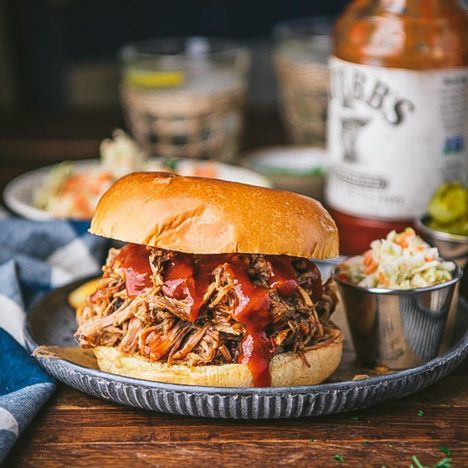
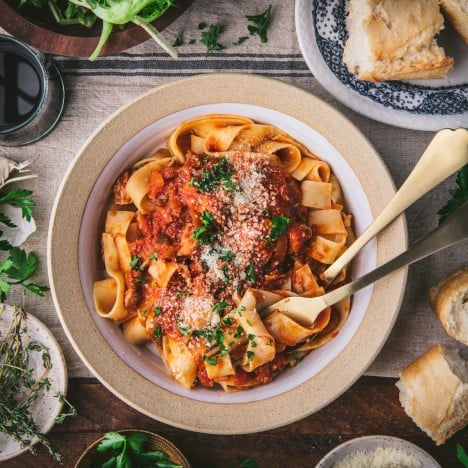
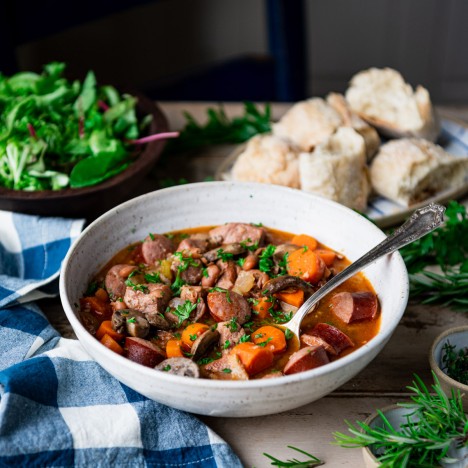





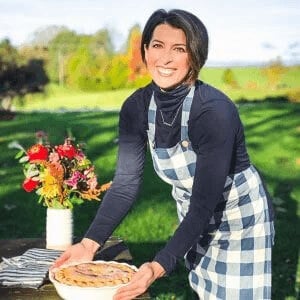

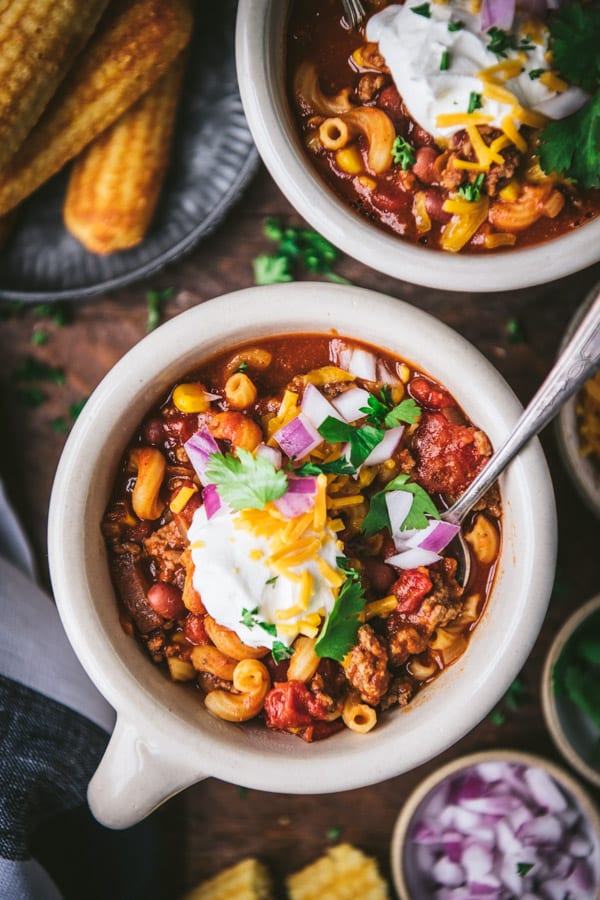
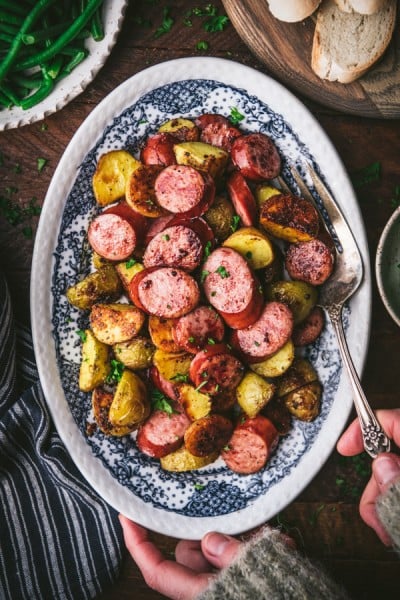








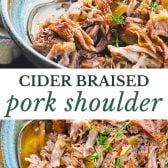
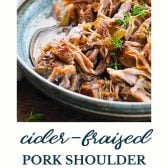
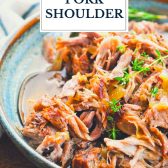
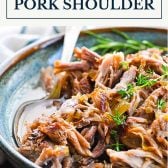
I just found my Christmas roast. Thanks!
One question: For making this in a Crock Pot should the apple cider and chicken broth be cut by half? It seems to me that the full amounts would be too much for cooking in a Crock Pot.
Hi, Deb! Yes, you can certainly cut the liquid in half to account for the slow cooker. Otherwise, you can always just strain off (or not use) any excess liquid that’s in the pot at the end of the cooking time. Either way will work. Enjoy!
Any difference when specifying apple cider versus apple juice? Or apple cider vinegar?
Hi, Lynn! Yes – you want the sweetness and the rich apple flavor that you get from apple cider. Don’t use apple cider vinegar — that will ruin the dish. Apple juice is probably okay, but it’s not nearly as flavorful as the cider. Hope that helps, and enjoy!
Is there a certain type of apple cider you are supposed to use?
Hi, Shelby! No, it doesn’t really matter, but the better the quality the better the taste. 🙂
I always use local, fresh, unpasteurized apple cider because it’s readily available at farm stands and orchards here in Virginia throughout the fall and winter. If you don’t have access to local, unpasteurized cider, look for a cloudy cider with no added sugars or spices. You can typically find these in the refrigerated section at your grocery store. I do not recommend using apple juice (which is typically sweetened and lacking deep flavor), hard cider, or sparkling cider. Hope that helps!
For a roast that is half the size that you suggested, are all other ingredients cut in half as well? I know that question might sound stupid but I wanted to double check.
Hi, Amanda! Not stupid at all! Since you’re feeding fewer people with the smaller roast, you can definitely use fewer veggies, etc. If you’d like to have extra vegetables in the pot, then it’s fine to keep more of those. The liquid is harder to say, because you might be able to get away with about half as much, but you’ll just have to see how it fills your Dutch oven once your ingredients are in the pot. You’ll need enough liquid to properly braise the meat, so it should come up about halfway on the side of the pork. You might find that you need the full amount of liquid, even with the smaller roast. I’d just eyeball it. 🙂
What size Dutch oven would I need for a 6-7 pound pork shoulder?
Hi Julie! A 7 quart Dutch oven would likely be best. Hope this helps!